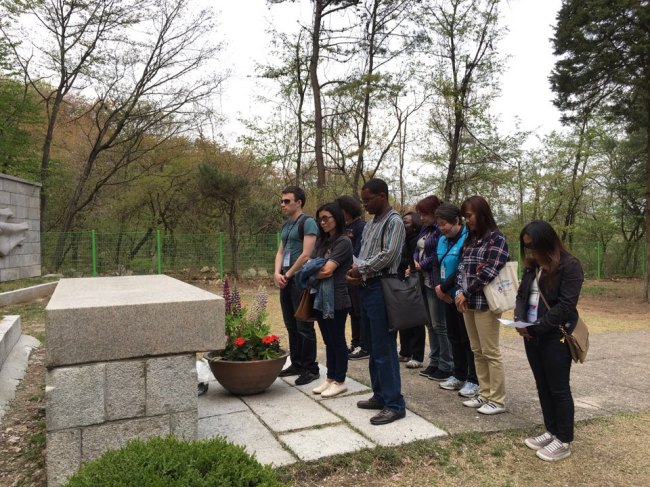Located near the serene Bukhansan National Park in northwestern Seoul, the April 19 National Cemetery is home to 199 victims who sacrificed their lives in the April Revolution of 1960.
Thousands of students had marched from Korea University to the presidential office on April 19, 1960, calling for the resignation of then-president Syngman Rhee to overthrow the autocratic First Republic of South Korea.
Police opened fire on protestors, wounding thousands and killing approximately 180. That day, the Rhee government proclaimed martial law in order to suppress demonstrations. The movement led to the resignation of Rhee and the transition to the Second Republic of Korea.
On Monday, a day prior to the anniversary of the April Movement, a group of foreign students visited the April 19 National Cemetery to learn about Korea’s past with the help of the Gangbuk-gu District Office in northwestern Seoul.
 |
A group of foreign students pay tribute Monday in front of the tombstone of patriot Yi Jun at the April 19 National Cemetery. Kim Da-sol/The Korea Herald |
“I cannot believe that this young boy was sacrificed,” said Wella L. Hoyle, a Hanshin University study abroad student from the Philippines, standing in front of the tombstone of Lim Dong-sung, who died at just 10 years old. Candy and chocolate were laid at his grave.
Upon hearing the interpreter’s explanation of one of Korea’s fiercest moments yearning for democracy, Hoyle said she was reminded of a political figure in her own country.
“Philippines also had a similar time when the country was ruled by one ruler for 21 years,” said Hoyle.
“Ferdinand Marcos placed the country under martial law, revamped the constitution, silenced the media and many were killed during his reign,” she added. But in 1986, public outrage led to the Philippines’ People Power Revolution, which removed him from power.
Victor Saidi Phiri, a student from Malawi, said protest for democracy has different definitions by time and country.
“There are some countries undergoing war in the African continent, whether it is physical or not,” said him.
“Since I am in Korea, I think it is integral to join the opportunity to know about the history (where) you’re staying. Before coming here, I thought South Korea was just as dangerous as in North Korea,” said Phiri.
A cultural tourism interpreter who volunteered to work with Gangbuk-gu Office said that she was glad to see foreign visitors learning to understand Korea’s spirit and historical moments.
“I tried to give them an easy and short explanation, to help them learn about the background in Korean history,” said Choi Gwang-young.
There are a total of 17 cultural tourism interpreters who voluntarily joined to be part of Gangbuk-gu Office’s regional cultural tourism program. They speak English, Chinese and Japanese to help visitors from abroad learn about the region’s historical monuments and cultural places.
“Although the interpretation service was launched just last year, we are seeing a growing number of people who are interested in the area, as well as the history behind it,” said Hwang Hyun-joon from Gangbuk-gu Office.
The walking trail of Mount Bukhansan and the April 19 National Cemetery are among the sites where the interpretation services are available. One can apply for the services through the district’s website at
www.gangbuk.go.kr.
By Kim Da-sol (
ddd@heraldcorp.com)








![[Today’s K-pop] Blackpink’s Jennie, Lisa invited to Coachella as solo acts](http://res.heraldm.com/phpwas/restmb_idxmake.php?idx=644&simg=/content/image/2024/11/21/20241121050099_0.jpg)